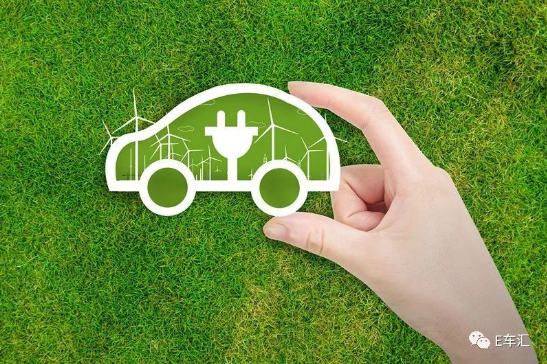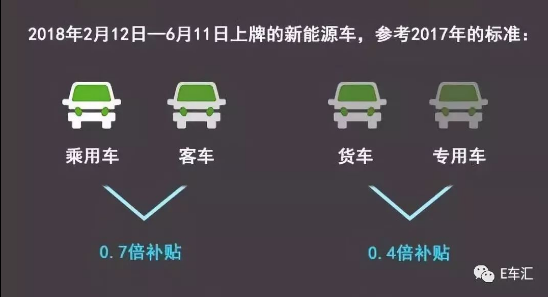In 2018, the new energy vehicle market experienced a three-stage subsidy for the first time, and also ushered in the double-point policy for replacement subsidies. The Regulations on Investment Management of the Automobile Industry pointed out to new entrants. Directions, new forces in the car have started to deliver, and the annual sales of new energy vehicles have broken millions for the first time...

This year's new energy vehicle market can be said to be splendid. Under the impetus of new energy and intelligent technology, the new energy automobile industry itself is undergoing changes. Products, technologies, models, formats, etc. are undergoing a change. “E Cars†will give a brief summary of China's new energy vehicle market in 2018 from the perspective of policy and market.
The first three-stage subsidy policy
The policy of subsidizing new energy vehicles has been going on for many years, and the subsidy program that has been adjusted year by year has also changed.
In the past, the annual subsidy program was scaled down on the basis of the previous year, and different requirements were put forward, but the subsidy program in 2018 was different. A transition period was given for a while while lowering the subsidy standard.

The transition period is from February 12, 2018 to June 11, 2018. During the transition period, the new energy passenger cars and new energy buses on the license will be subsidized 0.7 times of the 2017 standard, and the new energy trucks and special vehicles will be subsidized by 0.4 times, and the fuel cell vehicle subsidy standard will remain unchanged. Before the transition period, the subsidy will be given according to the 2017 standard, and after the transition period, the subsidy will be given according to the 2018 standard.
The “E-Bus†is expected to be similar to the subsidy policy of 2019. The corresponding transition period will be set, and the company will be given a buffer period while the subsidies are lowered.
Double integration policy officially implemented
In September 2017, the double point management method was announced, and the point accounting system and management platform were established, which clarified the threshold for the point accounting method and the point ratio requirement. This management method was officially implemented on April 1 this year.

For passenger car enterprises with annual production capacity or import volume of less than 30,000 vehicles for traditional energy passenger vehicles, the new energy vehicle integral ratio requirement is not set; if it reaches 30,000 or more, the integral ratio requirement is set from 2019, among which : The ratio of points for 2019 and 2020 is 10% and 12% respectively. The proportion of points for 2021 and subsequent years is separately announced.
Judging from the calculation method of double integrals, the policy puts forward certain requirements on the fuel consumption of passenger cars and the proportion of new energy vehicles. Under such circumstances, traditional fuel vehicle manufacturers need to have excess new energy points to deduct in the face of negative points. The source of new energy points is only purchased or generated by themselves. It is obviously not cost-effective to purchase points.

Driven by the double-point policy, whether it is a self-owned brand or a joint venture, the development of new energy vehicles has mentioned a considerable strategic height. It can be said that the implementation of the double-points policy is an important driving force for car companies to control fuel consumption and develop new energy vehicles, and has long-term significance for the development of new energy vehicles.
Significant changes in production qualifications
The "Regulations on Investment Management of the Automobile Industry" will be implemented on January 10, 2019, to build a Sino-foreign joint venture car production enterprise project, and to build a new pure electric passenger vehicle production enterprise (including the existing automobile enterprises to produce pure electric passenger vehicles across the class). The auto investment projects approved by the provincial government and the rest are no longer subject to approval management and are adjusted to record management.

In the formal regulations, the country's threshold for new pure electric passenger car projects has been further improved, especially for corporate legal person shareholders. I believe that in the next period of time, the players who drown in the tidal wave of the car will withdraw, and the industry will usher in a new round of purification.
New car products
In 2018, it was the year in which the new power of the car was concentrated. Many brands released the first product or ushered in the brand's first appearance, almost all of which were piled up with electric cars.

In 2018, Weilai, Weimar, Future, Hezhong, Xiaopeng and other new car companies listed on the market. It can be said that everyone is vying to hand over the 2018 answer. However, in 2019, there will be more and more electric vehicle products for independent auto companies, joint ventures, and imports. Whether the new forces in the auto industry have the ability to compete with them, everything is still unknown.
The first million years
In the exhausted automobile market, the new energy vehicle market is unique and maintains a high growth.

According to the latest data of China Association of Automobile Manufacturers, from January to November this year, the production and sales of new energy vehicles in China reached 1.0535 million and 1.0298 million, an increase of 63.63% and 68%, and the annual production and sales of new energy vehicles exceeded one million for the first time. Among them, the production and sales of pure electric vehicles were 806,600 and 790,900 respectively, up 50.30% and 55.66% year-on-year; the production and sales of plug-in hybrid vehicles were 246,600 and 238,600 respectively, up 130.27% and 127.58% respectively. In the same period, China's automobile production and sales were 25.325 million and 25.419 million, down 2.59% and 1.65% year-on-year.
Judging from the current situation, although China's new energy vehicle subsidies have decreased this year, sales still maintain growth, showing that the real market consumption demand for new energy vehicles is increasing. The China Automobile Association expects that the total sales volume of new energy vehicles in China is expected to exceed 1.2 million this year. In 2019, the total sales volume of new energy vehicles in China is expected to reach 1.6 million.

Under the guidance of the policy, the development of the new energy vehicle market has entered a new stage. In 2018, various policies for the new energy auto industry have already landed. In 2019, under the conditions of basic policy setting, the new energy auto market will have a more dazzling performance.
KRTP Cloud Control System Extension
Sichuan Kangruntengpu Photoelectric Technology Co., Ltd. , https://www.kangruntoplighting.com